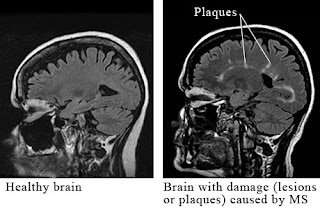Indeed, multiple sclerosis, or MS, is one of the most well-known yet mysterious neurological conditions we know about.
MS and myelin
MS is an inflammatory disorder affecting the central nervous system (brain/spinal cord) and its ability for nerve cells to communicate with one another.
Our individual nerve cells (neurons) have a fatty substance called myelin surrounding the long conducting axon fiber. If you picture the axon like an extremely long hot dog, myelin resembles hot dog buns lined up along its length.
Myelin allows neuron communication to occur much more rapidly. Instead of generating action potentials (rapid electrical changes) along each point in the axon, the action potential can "jump" over the myelin. Instead, action potentials are regenerated only at each node of Ranvier (see above), where there are breaks in the myelin sheath.
In MS, however, the body's immune system attacks the myelin sheath, causing it to break down and scar tissue to form. This process is called "demyelination." As a result, communication slows significantly. Check out these teased axon fibers showing progressive demyelination (the myelin is stained black):
So why is this happening?
Why exactly does the immune system attack myelin in MS? The cause is not well-understood, but some interesting correlations have been found. (Remember: correlation does not mean causation!)
 |
| Richard Pryor's 1995 cover of People magazine, nine years after his MS diagnosis and ten years before his death. |
• The further from the equator, the higher the incidence of MS—perhaps due to decreased sunlight and vitamin D production.
• Exposure to stress, smoking, and toxins may increase the risk.
• A number of microbes and viruses have been proposed as causes, but none have been definitively proven.
Diagnosis
Due to widespread demyelination in the central nervous system, symptoms vary greatly: numbness, tingling, weakness, difficulty with balance/coordination, trouble speaking/swallowing, visual problems, and pain. Typically, these symptoms occur in increasingly worsening episodes, called relapses; illness, stress, and pregnancy can make one more susceptible to relapse.
Because of this range of symptoms, MS is typically diagnosed via biopsy to examine signs of demyelination (like the image above). A lumbar puncture ("spinal tap") can also test cerebrospinal fluid for IgG, an inflammatory marker found in 75-85% of MS sufferers.
Treatment and...hope for regeneration?
Depending on the person's systems, a range of drugs—from pain relievers to mood stabilizers to bowel movement enhancers—may be prescribed. Physical activity, including aerobic exercise and strength/balance training, are particularly important for slowing disease progression. Even medical marijuana has been shown to improve symptoms of severe pain and muscle spasms.
 In January, a paper published in Cell Stem Cell by Franklin Robin's group at Cambridge found that applying monocytes from young mice can rescue demyelination.
In January, a paper published in Cell Stem Cell by Franklin Robin's group at Cambridge found that applying monocytes from young mice can rescue demyelination.Advanced age decreases the ability for humans and animals to re-myelinate their neurons. This barrier poses a particular problem in the aging population suffering from MS, for which demyelination occurs.
Franklin and colleagues used a technique called "toxin-induced focal demyelination" in order to remove myelin in the spinal cord, resembling multiple sclerosis. Demyelinated mice receiving young monocytes (3rd panel, left) demonstrated significantly more myelination than demyelinated mice not receiving monocytes (2nd panel). In fact, this remyelination was comparable to what was seen in young control mice (compare 1st and 3rd panel.
Says Franklin, "For individuals with MS, this means that in theory regenerative therapies will work throughout the duration of the disease."
What's the best way to treat MS: prevent it? Treat the symptoms? Try to reverse the problem? Given that we don't know the cause, it's difficult to say. While a cure may not be imminent, life expectancy of sufferers is only 5-10 years less than non-sufferers these days—a drastic improvement from the past.
Images courtesy Intermountain Medical Imaging, Generic Look, and People.
Ruckh JM, Zhao JW, Shadrach JL, van Wijngaarden P, Rao TN, Wagers AJ, & Franklin RJ (2012). Rejuvenation of regeneration in the aging central nervous system. Cell stem cell, 10 (1), 96-103 PMID: 22226359




No comments:
Post a Comment
I appreciate all comments and strongly encourage discussion on the topics I write about! Please be respectful to me and other readers. Spam comments will not be published.